
|
|
||||
|
|
|
|
||
| Open A | ||||
| Participants | ||||
| Starting rank list | ||||
| Results/Pairings | ||||
| 1 2 3 4 5 6 7 8 9 | ||||
| Table | ||||
| 7 8 9 | ||||
| ONLINE | ||||
| Server 1 Server 2 | ||||
| Games | ||||
| PGN | ||||
| Download | ||||
| Photo | ||||
| 1 2 3 4 5 6 7 8 9 10 11 | ||||
| Commentary | ||||
| 1 2 3 4 5 6 7 8 | ||||
| Interview | ||||
| 1 2 | ||||
| Open B | ||||
| Participants | ||||
| Starting rank list | ||||
| Results/Pairings | ||||
| 1 2 3 4 5 6 7 8 9 | ||||
| Table | ||||
| 7 8 9 | ||||
| PGN | ||||
| Download | ||||
| Photo | ||||
| 1 2 3 4 5 6 7 | ||||
| Open C | ||||
| Participants | ||||
| Starting rank list | ||||
| Results/Pairings | ||||
| 1 2 3 4 5 6 7 8 9 | ||||
| Table | ||||
| 7 8 9 | ||||
| ONLINE | ||||
| Server 1 Server 2 | ||||
| Games | ||||
| PGN | ||||
| Download | ||||
| Photo | ||||
| 1 2 3 4 5 6 7 8 9 10 11 12 | ||||
| Interview | ||||
| 1 2 | ||||
| Open D | ||||
| Participants | ||||
| Starting rank list | ||||
| Results/Pairings | ||||
| 1 2 3 4 5 6 7 8 9 | ||||
| Table | ||||
| 7 8 9 | ||||
| PGN | ||||
| Download | ||||
| Photo | ||||
| 1 2 3 4 5 6 7 8 | ||||
| Interview | ||||
| 1 2 | ||||
| Open E1 | ||||
| Participants | ||||
| Starting rank list | ||||
| Results/Pairings | ||||
| 1 2 3 4 5 6 7 8 | ||||
| Table | ||||
| 7 8 | ||||
| Photo | ||||
| 1 2 3 4 5 6 7 8 9 10 11 12 13 | ||||
| PGN | ||||
| Download | ||||
| Open E2, E3 | ||||
| Table | ||||
| Table | ||||
| Open F | ||||
| Participants | ||||
| Starting rank list | ||||
| Photo | ||||
| 1 | ||||
| Table | ||||
| Table | ||||
| International research Conference | ||||
| News | ||||
| 1 2 | ||||
| Program | ||||
| Resolution | ||||
| Summary | ||||
| Photo | ||||
| 1 2 | ||||
| Arbiter's seminar | ||||
| Photo | ||||
| 1 | ||||
| Photo | ||||
| Opening ceremony | ||||
| Segui | ||||
| M.E.Nikolaev visit | ||||
| Closing ceremony | ||||
| Press releases | ||||
| Press releases | ||||
| 1 2 3 4 5 6 7 8 9 10 11 12 13 14 15 16 17 | ||||
| MOSCOW OPEN 2005-2009 | ||||
| 2005 | ||||
| Festival 2005 | ||||
| 2006 | ||||
| Festival 2006 | ||||
| 2007 | ||||
| Festival 2007 | ||||
| 2008 | ||||
| Festival 2008 | ||||
| 2009 | ||||
| Festival 2009 | ||||
| Links | ||||
| Moscow chess federation | ||||
| Official site | ||||
| Moscow Sport committee | ||||
| Official site | ||||
| Russian Chess Federation | ||||
| Official site | ||||
| FIDE | ||||
| Official site | ||||
|
|
||||
 |
|
|
Game is commented by IM Vladimir Barsky
G.Veskovi – M.Krylov
Round 5
The fifth round has pleased spectators with a duel of Brazilian grandmaster Giovanni Veskovi and the young Moscow master, student RSSU Michael Krylov. Four (!) pawns at once, on two at each of the opponents, have reached a promotion square.
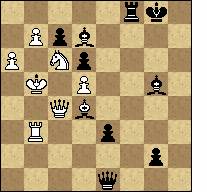
The position on the diagram reminds a typical modern etude where it is difficult to define, which way pawns go. The short inquiry: in a classical variant of King’s Indian Defence white King has been compelled to leave its residence on g1 quickly.
51...g1Q
Grandmaster Nepomniachtchi Ian has offered the unexpected decision - 51... Rb8, braking both pawns on a promotion square.
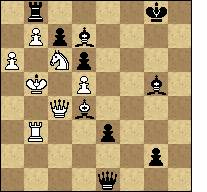
However this "mysterious" move has a defect - White can advance to the attack on the King:
52.Qc2! Qf1+ 53.Ka5 Bf5 54.a7! with a win.
The amazing variant was found by Rybka:
51...Qf1! 52.Rd3 g1Q 53.a7 Qg4 54.a8Q e2 55.b8Q e1Q

After 52.a7 (instead of 52.Rd3) Black also win: 52...Bxc6+! 53.dxc6+ 53…d5! 54.Qd3 Qxd3+ 55.Rxd3 g1Q
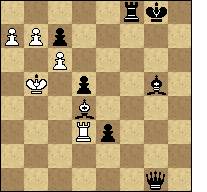
56.a8Q (loosing 56.b8Q Qb1+ 57.Ka4 Rxb8) 56...Qb1+
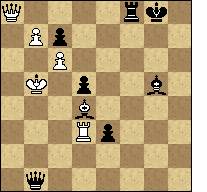
57.Ka4 (after 57.Kc5 Be7+ 58.Kxd5 Qb5+ Black have a strong attack) 57...Qc2+

58.Ka5 (58.Rb3 Qxc6+ 59.Rb5 Rxa8+; 58.Ka3 Be7+) 58...Qa2+ 59.Kb4 Rxa8.
52.a7 Qgf1 53.a8Q
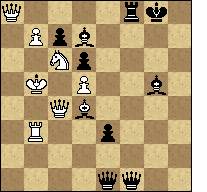
53...Qxc4+
Even stronger 53...Bxc6+ 54.dxc6+ Qxc4+! (Badly 54...d5? 55.Qxf8+! Qxf8 56.Qd3, White wins) 55.Kxc4 d5+
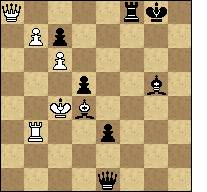
54.Kxc4 Qf1+ 55.Rd3 e2
The similar idea could be expressed: 55...Bxc6 56.dxc6 d5+ 57.Kxd5 Qf7+ 58.Kc5 (58.Ke4 Qf5#) 58...Be7+ 59.Kb5 Qd5+ 60.Ka6 Qc4+ 61.Ka5 (61.Ka7 Qa4#) 61...Qb4+ 62.Ka6 Qa4#.
56.Bc3 Bd8??
Awful error after which everything could turn over upside down. It was correct 56... Bxc6 57.dxc6 d5 +, and black win.
57.b8Q e1Q 58.Bxe1 Bxc6
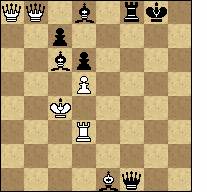
In terms of a lack of time Veskovi has decided to play more reliably. The winning way was mentioned by grandmaster Farrukh Amonatov: 59.Qxc6! Rf4 + 60.Kb3!, and the white King leaves from checks soon. For example: 60 … Qxd3 + 61.Bc3 Qb1 + 62.Ka3 Qc1 + 63.Qb2 etc.
59...Bxa8 60.Qg5+ Kf7
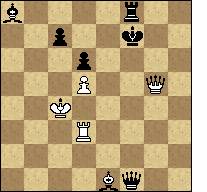
.
White should have played 61.Bh4! with a perpetual check
61...Ke7 62.Bh4+ Kd7 63.Qg4+ Rf5 64.Kc3 Qf4!
Practical and is very strong! Michael Krylov has estimated a situation truly and understood that White won’t rescue a pawn d5. Trouble come to the end, the technical stage begins.
65.Qxf4 Rxf4
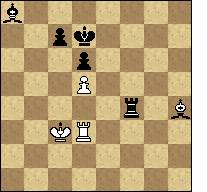
66.Be1 Bb7 67.Rd4 Rf5 68.Kc4 Ba6+ 69.Kc3 Be2 70.Rd2 Bh5
Bishop is translated on f7, and the Rook will attack a pawn on 5th horizontal. White position is very difficult.
71.Bh4 Rf4 72.Rd4 Rf3+ 73.Rd3 Rf7 74.Rd2 Rf5 75.Rg2 Rf3+ 76.Kd2 Rf4 77.Rg7+ Kc8 78.Rg8+ Kb7 79.Bd8 Bf7 80.Rg7 Kc8 81.Ke3 Rf1 82.Ke2 Rf4 83.Ke3 Rf5
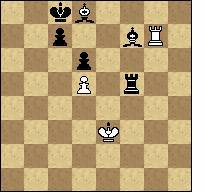
Not better 84.Rg5 Rf1 85.Ke2 Rc1 86.Be7 Rc5 etc.
84...Bxd5 85.Rg5 Rf3+ 86.Ke2 Bc6 87.Rg8+ Kb7 88.Rg7 Rc3 89.Bg3 Bb5+ 90.Kd2 Rd3+ 91.Kc2 Kb6 92.Rg6 Rd5 93.Kc3 Bd3 94.Rg4 c5 95.Rf4 Be2 96.Bh2 Rd3+ 97.Kc2 Rh3 98.Rf2 Bd3+ 99.Kd2 d5 100.Be5 Be4 101.Rf8 Kb5 102.Rc8 d4 103.Bd6 Rh5 104.Rb8+ Kc6
White resigns
|
|
|
|||||||||||||||||||||||||||||
|
|
|
|
|
|
|
|||||||||||||||||||||||||
|
|
|
|
|
|||||||||||||||||||||||||||
|
|
|
|
|
|||||||||||||||||||||||||||
|
|
|
|
|
|||||||||||||||||||||||||||
|
|
|
|
||||||||||||||||||||||||||||
|
|
|
|||||||||||||||||||||||||||||
|
|
|
|||||||||||||||||||||||||||||
|
|
|
|||||||||||||||||||||||||||||
|
|
|
|
|
|||||||||||||||||||||||||||
|
|
|
|
|
|
|
|
|
|
|
|||||||||||||||||||||
|
|
|
|
|
|||||||||||||||||||||||||||
|
|
|
|
|
|
|
|
||||||||||||||||||||||||
|
|
|
|
|
|
|
|||||||||||||||||||||||||
|
|
|
|
||||||||||||||||||||||||||||
|
|
|
|
||||||||||||||||||||||||||||
|
|
|
|
|
|||||||||||||||||||||||||||
|
|
|
|
||||||||||||||||||||||||||||
|
|
|
|||||||||||||||||||||||||||||
|
|
|
|
|
|
|
|
|
|
|
|
|
|
|
|
|
|
|
|
|
|
|
|
|
|
|
|
|
|
|
|